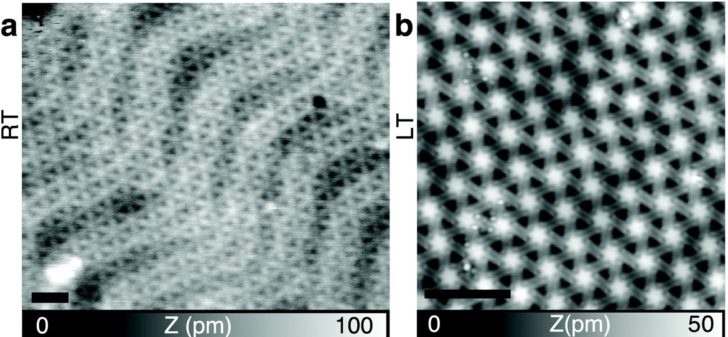Complex molecules on surfaces – best master’s thesis in nanoscience

At the Swiss Nanoscience Institute’s first graduation ceremony, Sebastian Scherb was honored for his work on a novel method to attach complex single molecules on surfaces. His work in Prof. Ernst Meyer’s team at University of Basel was named “Best master’s thesis in nanosciences 2018”.
Current methods work for small molecules only
Thanks to self-assembly of molecules, functional surfaces can be built with atomic precision. Such products can then be used in various fields, including electronics for example. Evaporation deposition is a method that is commonly employed to create atomical layers of smaller molecules on surfaces, from gold or potassium bromide, among many others. But larger and more complex molecules do not endure the necessary heat required to reach the boiling point and denaturate.
In his prized master’s thesis, Sebastian Scherb investigated whether or not another method, called electrospray deposition, would be a suitable alternative. In this case, molecules are transferred gently from the liquid to the gaseous phase by transfer of electrical charges. Single molecules are sprayed onto a surface in a vacuum where they will assemble themselves in molecular layers.
Focus on two graphene-like compounds
Scherb focused on two compounds that are similar to graphene and promise widespread use thanks to their electrical characteristcs. Graphylene-1 is a hexagonal molecule with alkane-chains on the outside – it looks like the wheel of a wagon. Functional groups can then be added to this „waggon wheel“, giving the molecule specific properties. The other compound Scherb investigated were graphene bands (quantum chains).
“It was highly interesting to investigate how differently these complex molecules behave on different surfaces“, Scherb says about the part of his work that fascinated him most. He did not only investigate graphylene-1 on gold and potassium bromide surfaces at room temperature, but also prepared them for analysis with atomic force and scanning tunneling microscopy at low temperatures (down to 5 degrees Kelvin).
Temperaturen (5° Kelvin) vor.
Encounter of unexpected results
Comparison between the graphs revealed an interesting, unexpected side effect. At lower temperatures, the single graphylene molecules lay much closer to each other than at room temperature. Simulations following up the master’s thesis suggest that the molecules are pushed apart from each other due to increasing mobility of the sidechains with higher temperatures. The relatively weak Van der Waals-forces responsible for the overall cohesion allow these variations depending on the temperature
Scherber conducted his research in the group of Prof. Ernst Meyer, who was very impressed with the results. “Sebastian managed to prepare large molecules in the shape of a wagon wheel with the use of an electrospray method under high vacuum conditions. He was then able to depict these molecules with high resolution atomic force microscopy and revealed an extraordinary high thermal expansion coefficient for these materials.”
The work has fascinated Scherber so much that he stayed with Meyer’s team in which he will now write his PhD thesis. “I really enjoy conducting these measurements. In addition, the cooperation and spirit is very good in this group”, he says.
Chemistry would have been first choice
Seven years ago, Scherber visited the info day of University of Basel, shortly before his Abitur. Back then he hadn’t imagined spending many of his working hours in the basement level of the department of physics to study molecules on surfaces. But now, he’s enthused about it. “I originally wanted to study chemistry, but then the presentation of the nanoscience degree program was so good, I decided to go for that instead”, Scherber recalls.
He doesn’t regret this decision, despite encountering difficult phases during his studies. As a student in a classical gymnasium in Lörrach, he dropped biology early and had to catch up a lot at university. “You just have to persist through phases like that. But in the end, it really payed off because I can look back on all the different subjects and use the knowledge I acquired from there.”
Scherber especially got to know different subject areas and working groups from SNI during block courses. Cold atom physics and working with the AFM appealed so much to him that he even wrote both his project papers on these subjects. The practical application of the AFM ended up fascinating him more than cold atoms however, which ultimately led to the prized master’s thesis.
News from Prof. Ernst Meyer’s group, in which Scherber conducted his thesis and will now write his PhD thesis can be found at the team’s website
Neuigkeiten aus der Gruppe von Prof. Ernst Meyer, bei dem Sebastian seine Masterarbeit absolviert hat und bei dem er jetzt auch promoviert, gibt es unter: Webseite des Meyer-Teams − Nanolino
Source: https://nano.swiss/aktuell/news/21-partner-news/212-komplexe-molekuele-auf-oberflaechen-preis-fuer-die-beste-masterarbeit-in-nanowissenschaften-geht-an-sebastian-scherb
Image source: https://pubs.rsc.org/en/Content/ArticleLanding/2018/NR/C7NR06261C#!divAbstract
Published paper in Nanoscale: https://pubs.rsc.org/en/Content/ArticleLanding/2018/NR/C7NR06261C#!divAbstract